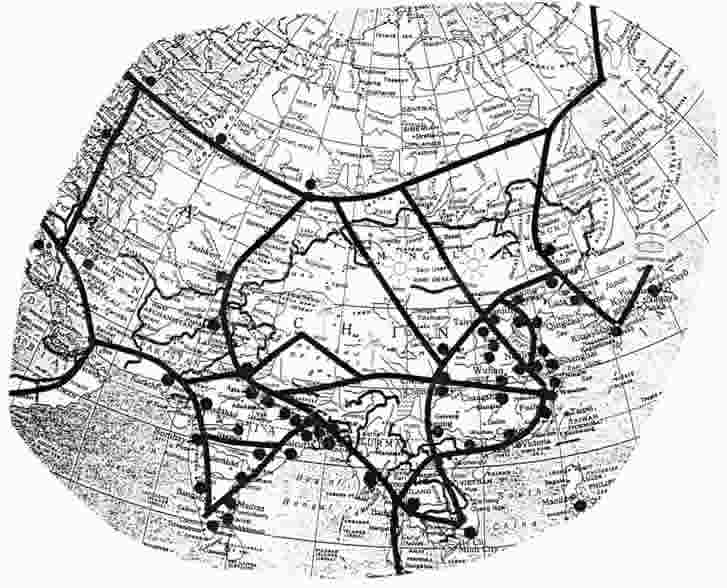
The Benefits to China and East Asia in Tapping Remote
Renewable Energy Resources
China has the world's largest population, and fastest
growing economy. The energy requirements for the next
several years have been determined at 15,000 MW annually.
This infrastructure development is designed to supply
the needs of a rapidly developing society, yet the
environmental implications of such growth could be
disastrous.
GENI is a tax-exempt, non-profit corporation in the
United States committed to improving the quality of
life for everyone without damage to the planet. Our
primary focus is the research and education of the
benefits to interconnecting electric power systems
between regions and continents, which an emphasis
on tapping remote renewable energy resources using
high-voltage transmission.
As reported this summer at the recent CIGRE (International
Conference on Large High-Voltage Electric Systems)
in Paris, electric power can now be transmitted thousands
of kilometers (7000 km for HVDC and 4000 km for HVAC).
Mr. Maher Abaza, Minister of Energy and Electricity
of Egypt, presented his scheme of linking the hydropower
potential of the Zaire River in Central Africa to
Western Europe for the mutual benefit of all nations.
This would provide the electrical infrastructure for
Africa's development, export a renewable resource
to replace polluting fossil power in Europe, and deliver
money back to Africa for development and debt repayment.
Mr. Abaza also said that this plan is feasible on
every continent.
Today, the economic and efficient transmission distances
are much farther than any political boundary, or the
thinking of most energy system planners (see CIGRE
paper 37-12,1984 "Present Limits of Very Long
Distance Transmission Systems). It was found that
if the source of energy was cheap, the reliability
and load losses were both acceptable even over tremendous
distances. Similar thinking in China would allow energy
trading with neighboring nations, and economic and
environmental benefits to both.
The advantages of system interconnection are well
known:
- load leveling -- daily time zone differences as
well as seasonal variations in demand
- emergency back-up
- peak power savings
- deferral of addition capacity requirements
- increased system stability
- improved frequency and voltage control
- ability to retire environmentally unsound or older
generation plants
China has common borders with Korea, Russia, Mongolia,
Kazakhstan, Kyrgyzstan, Tajikistan, Pakistan, India,
Nepal, Bhutan, Burma, Laos, Vietnam, and Hong Kong.
The potential benefits of trading electricity between
these countries is tremendous. Since the world's two
largest populations of China and India have different
peak demand patterns, the interconnection between
these countries would offer significant daily savings.
Just as important, abundant renewable energy sources
surround China, and are within transmission reach
of the population centers in the central region and
eastern seaboard. Recent Chinese/Russian trade cooperation
could enable the hydropotential of the Ob, Yenisey,
Lena and Kolyma River systems to be tapped for import.
The Penzhinaskaya Gulf in the Okhotsk Sea offers one
of the world's premier tidal sites (80 GW potential).
Both the Mongolian and Tibetan Plateau have enormous
solar and wind potential. The new Variable Speed Wind
Turbines (Kennetech Corp. in US) deliver power at
US$0.05 per kilowatt -- competitive with base-load
coal fired generation. The Himalayan Mountains could
provide sufficient renewable power to meet the energy
needs of China and India for several decades.
Our focus is on interconnections for the system benefits.
Our focus is on tapping renewables for the environmental
benefits. Since most of the generation currently planned
in China is fossil-fired, the pollution can only be
worsened as new coal plants are commissioned. The
ability to tap large scale renewable resources in
cooperation with neighboring nations will diminish
the environmental impact on the region while enhancing
the economic prosperity.
Quoting from the "China Power Projects Directory"
(1994, editor Stuart Becker) -- "China has the
largest hydro-electric power resources in the world
with a potential generation capacity of 378,000 MW,
but at present only 11% of resources are being utilized.
The country also has one of the largest coal reserves
in the world. The distribution of coal and hydropower
in China is quite uneven geographically. More than
90% of hydropower resources are concentrated in the
west China areas, two thirds of the coal reserves
are scattered in Shanxi, Inner Mongolia and Shaanxi,
while economically developed regions are principally
located in coastal areas. It is then imperative to
expand and interconnect power networks, by adopting
DC links and AC transmission lines with 500 KV and
higher voltage levels. China needs interconnected
networks to be able to meet its needs by sending electricity
from West to East as well as from North to South."
The map below indicates population
centers and densities (57 million people are represented
by each dot). Large potential renewable sites and
transmission schemes are identified.

|